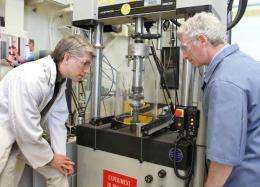Researchers find way to mitigate traumatic brain injury

(PhysOrg.com) -- Researchers at Lawrence Livermore National Laboratory (LLNL) have found that soldiers using military helmets one size larger and with thicker pads could reduce the severity of traumatic brain injury (TBI) from blunt and ballistic impacts.
Their results came after a one-year study funded by the U.S. Army and the Joint IED Defeat Organization (JIEDDO) to compare the effectiveness of various military and football helmet pads in mitigating the severity of impacts.
The findings have been presented to the Program Executive Office (PEO) Soldier, which is directed by Brig. Gen. Peter Fuller and is the U.S. Army acquisition agency responsible for everything a soldier wears or carries.
In 2009, Gen. Peter Chiarelli, of the Vice Chief of Staff of the Army, directed JIEDDO to review the mitigation capabilities of the U.S. Army's Advanced Combat Helmet (ACH) against impact injuries. LLNL researchers Willy Moss and Mike King were tasked to determine if the helmet pads used by the NFL might protect against militarily relevant impacts better than the pads currently used in the ACH.
"A review committee chose us to do this study based on our previously published work on blast-induced TBI. The committee concluded that LLNL had the best mix of skills and capabilities to quickly and effectively address the Defense Department's concerns," Moss explained.
Five types of pad systems were studied-those currently and previously used by the Army, two used in NFL helmets, and one used in other protective sports equipment. The two Army systems consist of bilayer (hard-soft) foam pads within a water-resistant airtight wrapper or coating. One NFL system consists of a thin foam pad and a hollow air-filled cylinder that buckles under load, and the other is a bilayer foam pad surrounded by a covering with air-relief channels that connect to adjacent pads in the helmet. The fifth pad consists of uniform dense foam.
Moss and King used a combination of experiments and computational simulations to study the response of the various pad systems to battlefield-relevant impacts to gain an understanding of how helmet pads provide protection against these impacts.
"For each of the pads, we did experiments to characterize the material properties of the individual foam components as well as the response of the complete pad system to a range of impact velocities," King said. "Then we did a large number of computational simulations examining how various parameters, such as foam material, pad thickness, pad area, and trapped air, affect the overall impact response. We also performed simulations of actual military helmet drop tests to confirm the validity of our computational methods and results."
The impact response simulations made use of the PARADYN finite element analysis software, a parallel version of the DYNA3D software developed by LLNL in the 1970s and 80s to model the deformation of solid structures under impact. (DYNA3D has been commercialized as LS-DYNA and is used worldwide by automotive, aerospace, bioengineering, manufacturing, and construction industries.)
The LLNL study found that for comparable thicknesses, none of the pads examined outperforms the pad currently used in the ACH system for battlefield-relevant impacts. The experiments and simulations confirmed that pad performance depends on impact velocity, with softer pads performing better at lower impact velocities and harder pads providing more protection at higher velocities. Because the NFL pads are not as soft as the military pads, they allow larger forces to be transferred to the head. This finding was not completely unexpected since football impacts differ from military impacts, so the requirements for the respective pads are different.
"Just because no pad in this study outperforms the pad that's currently used in the ACH doesn't mean that an improved system can't be devised," said Moss.
The most important result of the study was that significantly increased protection could be attained by modest increases in pad thickness. The current military pad is about three-quarters of an inch thick. Moss and King found that increasing pad thickness by an extra eighth to quarter inch could make a large difference in reducing the accelerations imparted to the head. Implementing such a change would require no "system reconfiguration," but simply the use of a one-size-larger helmet with correspondingly thicker pads.
Use of a one-size-larger helmet also would provide additional protection against non-penetrating bullets or metal fragments, due to the extra space into which the inside surface of the helmet could expand without contacting the head.
"What we found amazing was that our results suggest a very-low-cost strategy for mitigating TBI that the Defense Department could implement immediately, providing there's no detriment to functional or operational requirements," said Moss.
"Our methods and results also are applicable to the civilian sector, particularly contact sports helmet design," King added. The NFL, as well as college and youth sports organizations, have increased efforts to find better ways to protect their athletes from head trauma.
"A combination of simulation and experiment like we've used here also could be used to evaluate and improve the design of various sports helmets. It's very gratifying that this work can help protect our soldiers in the field and also benefit professional and youth athletes."
JIEDDO continues to work with LLNL to examine thicker pad systems with the intent of further protecting soldiers against impact and blast injuries caused by improvised explosive devices (IEDs). The next step will be to further explore pure blast injuries.


















